Apple-flavored Ubuntu: Ubuntu on Apple iMac
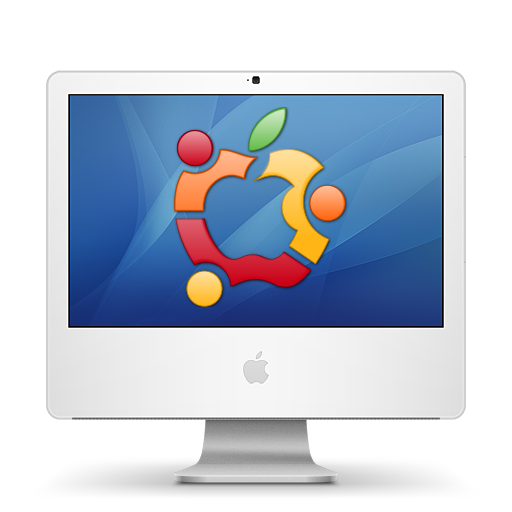
1. Background
I needed to buy a computer. This happens sometimes.
In my case, the situation was this: I changed work, and the only computer I had was a working laptop, which, of course, had to be given away.
A couple of years ago, I (once again) moved to Ubuntu, and I couldn’t get down anymore: the further, the more I got attached to it and the more annoyed and disliked Windows. My wife on a netbook, of course, is Ubuntu Netbook Edition . I also installed Ubuntu's mother-in-law (living thousands of kilometers from me), and although more than a year has passed, no serious problems have arisen either with the computer or with my mother-in-law. Ubuntu is also the main system on a working laptop, and for programs that need to be run on Windows, a free VMware Player is used(and Windows, which came with a laptop included).
In short, I have not considered alternatives to this system and have never intended to.
I proceeded to choosing a suitable computer. I dropped the laptops immediately, because tired of small screens and uncomfortable keyboards. Desktops take up extra space on the table, gather dust and noise.
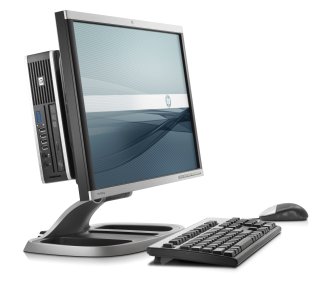 So the idea was born to buy a candy bar. But products from HP or Packard Bell look just monstrous (most annoying are the tons of silly stickers “Intel® Inside ™”, “Graphics by Nvidia®”, “Designed ™ for Windows®” that spoil everything, and so it’s not very positive impression from product), and at the same time not so cheap. I tried to find at least a monitor with a design similar to Apple products, but the stores only sell nightmares made of shiny black plastic with a bunch of ryushechok and buttons, which already repel them with their single, dusty look on the store shelf. Aluminum iMacs stand proudly here, standing out among them, like a white swan among black crows.
So the idea was born to buy a candy bar. But products from HP or Packard Bell look just monstrous (most annoying are the tons of silly stickers “Intel® Inside ™”, “Graphics by Nvidia®”, “Designed ™ for Windows®” that spoil everything, and so it’s not very positive impression from product), and at the same time not so cheap. I tried to find at least a monitor with a design similar to Apple products, but the stores only sell nightmares made of shiny black plastic with a bunch of ryushechok and buttons, which already repel them with their single, dusty look on the store shelf. Aluminum iMacs stand proudly here, standing out among them, like a white swan among black crows. Prices, of course, bite. In Amsterdam MediaMarkt (I livein the Netherlands) the cheapest iMac 21.5 ”costs € 1099 (until recently they had a special offer in the online store when all iMacs were sold a hundred cheaper and this computer could be bought for € 999. But I missed it). iMac 27 ”costs from € 1499 (Intel Core2 Duo 3.06 GHz) to € 1999 (Intel Core i7 2.66 GHz).
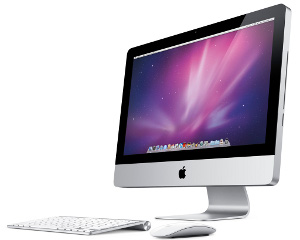 On the other hand, for such a monitor (diagonal 27 ”, LED-backlight, 2560x1440) and a computer with such characteristics (including, by the way, a wireless keyboard and mouse), even without taking into account the design and the aluminum case, the price of one and a half thousand seems quite justified. Well, the design, as I already wrote, is unique.
On the other hand, for such a monitor (diagonal 27 ”, LED-backlight, 2560x1440) and a computer with such characteristics (including, by the way, a wireless keyboard and mouse), even without taking into account the design and the aluminum case, the price of one and a half thousand seems quite justified. Well, the design, as I already wrote, is unique. So in a natural way, the choice gradually narrowed to Apple products. A cursory study of the issue ( raised, by the way, on Habré), showed that it is quite realistic to install Ubuntu on iMac. The problems for Linux for human beings are observed only with the built-in Bluetooth adapter and with advanced keyboard and mouse functions. Since the computer itself was important to me, and not the keyboard with the mouse, this did not stop me.
2. Apple iMac
So, iMac. There was a difficult choice between two available types: 21.5 ”and 27”. In a duel of stinginess and greed, the latter won. Still, we live once! I decided to take the younger iMac 27 ”model, since the more expensive ones differ only in a more powerful processor and video card, which I (as well as additional power consumption and heating) did not need.
There was another action in MediaMarkt: it was in this model, for the same € 1,499, that instead of 4 GB of memory they put 8 - a trifle, but nice! Although I didn’t plan to put the 64-bit version of the system there (and the 32-bit version sees only 3 GB), but it’s like that - overgrowth.
The seller pulled out a box from the bowels of the store, so healthy and heavy that I realized that it was necessary to park closer. It weighs 20 kg, of which about 14 weighs the monoblock computer itself. But about the boxes a little later.
What did I buy? Turn to the dry numbers and letters:
 |  |
Dimensions
- Height: 51.7 cm
- Width: 65 cm
- Depth: 20.7 cm
- Weight: 13.8 kg
Main
- CPU: Intel Core2 Duo 3.06 GHz
- Memory: 8 GB DDR3 SDRAM
- HDD: 1 TB 7200-rpm Serial ATA
- Optical Drive: Slot-loading SuperDrive, DVD ± R / RW, 8x
Display
- Diagonal of 27 inches (68.6 cm), LED backlight, active TFT-matrix, IPS technology
- Resolution: 2560x1440 pixels
- Brightness: 375 cd / m 2
- Wall mounting possible using standard VESA-compatible mounting (VESA Mount Adapter Kit sold separately)
- Number of colors: millions
- Viewing angle: 178 ° in both planes
- Aspect Ratio: 16: 9
Graphics and video
- Video card: ATI Radeon HD 4670, 256MB of GDDR3 memory
- Video camera: iSight, built-in, resolution 1280x1024 pixels
- Mini DisplayPort: input and output, DVI, VGA and dual-link DVI supported (adapter sold separately)
- Simultaneous support for full resolution on the integrated display and up to 2560x1600 pixels on the external (30 inches)
Audio
- Built-in speakers
- Two 17-watt amplifiers
- Headphone output or digital optical
- Line input or digital optical
- Built-in microphone
Network support
- Wi-Fi: 802.11a / b / g / n (up to 300 Mb / s)
- Bluetooth: 2.1 + EDR
- Ethernet: Gigabit 10/100 / 1000Base-T, RJ-45 connector
Periphery
- FireWire: 1 port FireWire 800, 7 W
- USB: 4 USB 2.0 ports
- Card Reader SDXC
Other
- Power Consumption: Up to 365 W
- Noise level: 18 dBA at unloaded system
- Case: aluminum, glass
- Package Includes :
- iMac
- Apple Wireless Keyboard
- Magic mouse
- Display Wipe
- Power cord
- DVD to install and restore
- Documentation Brochure
Unpack
The box was brought with honor to the house where the device underwent traditional unpacking and anrapping, then in pictures (everything is clickable to impossibility).
1. A beautiful white box is hidden in another, ugly, from unpainted cardboard. Say, we remember the environment, we remember: 2. 3. Even in terms of packaging materials, Apple is concise: 4. In the white box are the keyboard, mouse and other little things: 5. And besides it, there is only a candy bar and a power cord in the box: 6. This , in fact, everything: 7. Put forward a box. Yeah, the keyboard and the little books: 8. Here it is - the result of full unpacking: 9. So the candy bar looks from the side, ahem, from the back (it is still covered with transparent plastic):
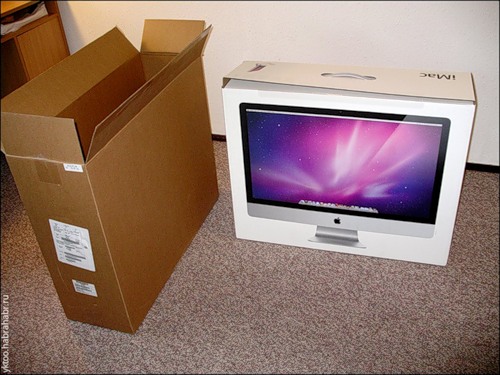
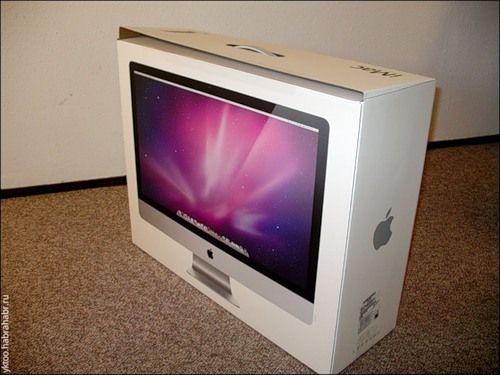
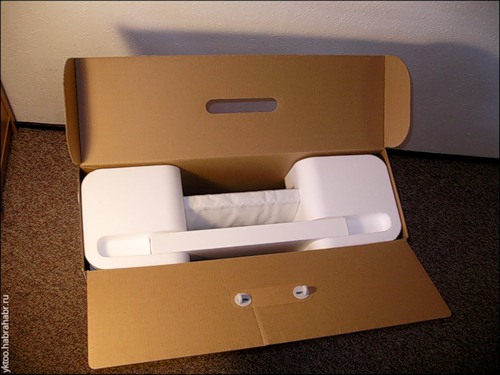

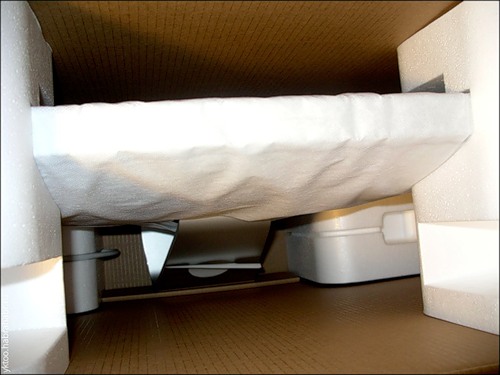
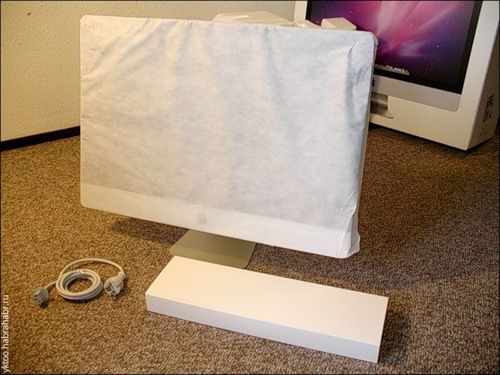
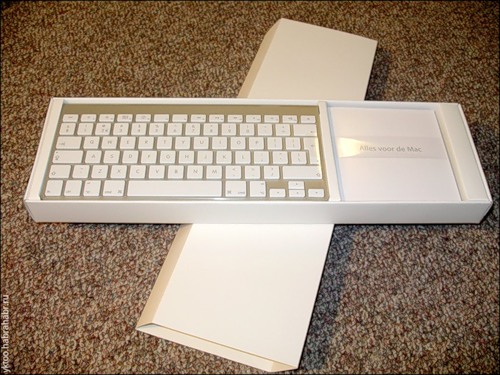

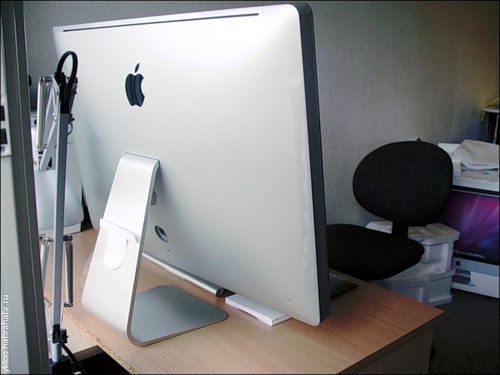
10. The contents of the white box close-up: 11. Instructions, a keyboard, a cloth for the monitor, a leaflet depicting the charms of the Magic Mouse, the Magic Mouse itself, a power cord: 12. Well, all the cables - and there are exactly one of them: the network - are connected. We press the treasured button from the back to the left: 13. A powerful chord is heard from the 17-watt speakers (for the first time it is impressive, the next one it annoys; it is treated with StartupSound.prefPane ), the download starts: 14. Turn on the mouse with the switch on the belly: 15. The preferred question is asked language: 16. The demonstration of the flying phrase “Welcome” begins in different languages: 17. 18. And now, finally, it came to “X”: 19. Indicate where we are:
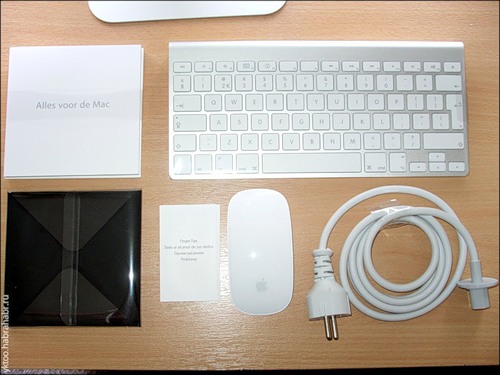


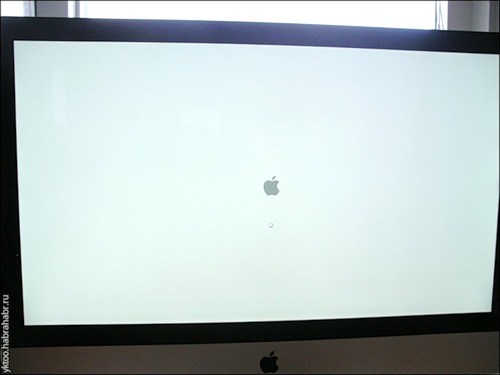
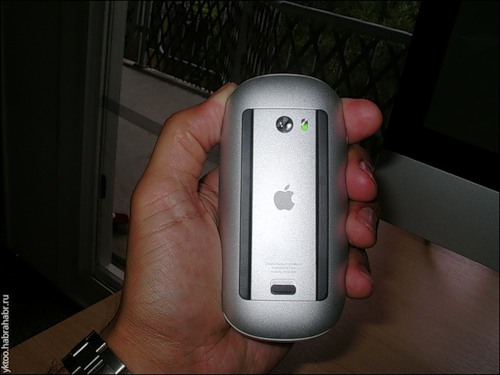
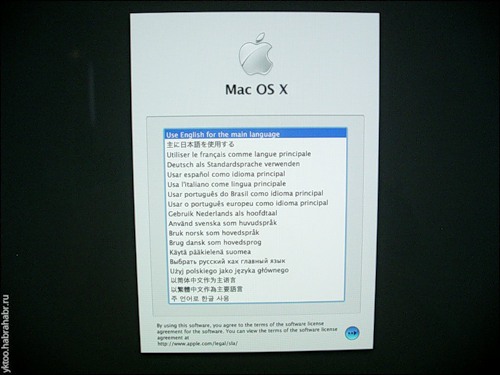

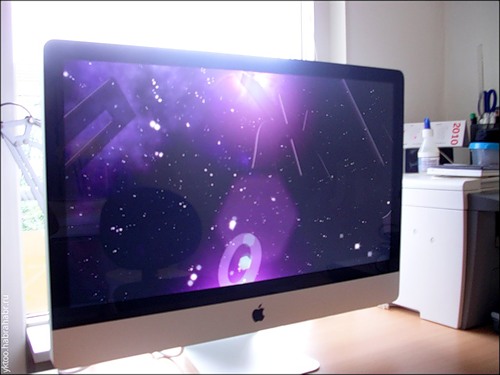
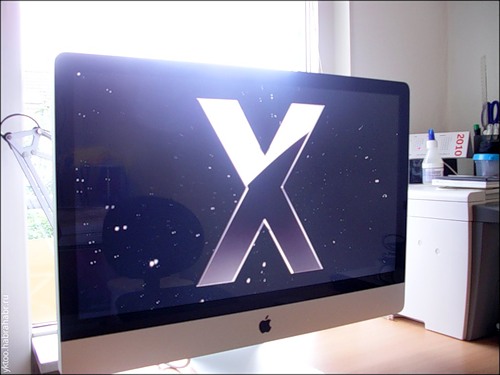
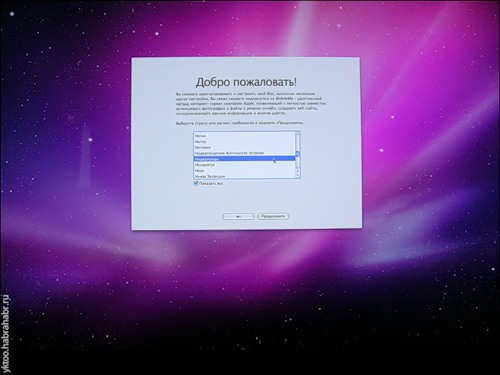
20. Choose your keyboard: 21. Do you have another Mac? Not? A pity: 22. Configure Wi-Fi: 23. In vain they try to identify us: 24. Enter everything you know about yourself: 25. A few thousand more questions: 26. We create the main account: 27. You can right there, with the built-in cameras, take pictures for dossier: 28. Work with MobileMe! Thank you, do not: 29. Thank you for reporting to this place: 30. The final result is exactly what was painted on the box:



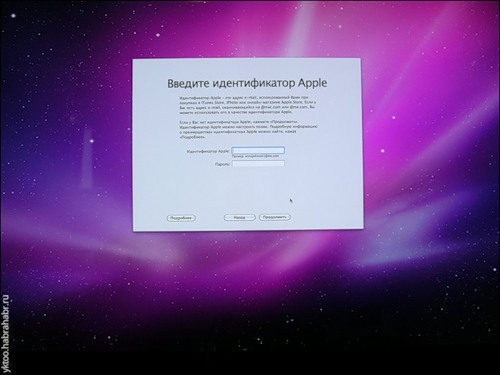

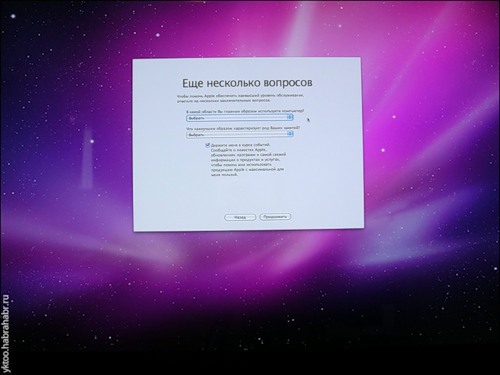


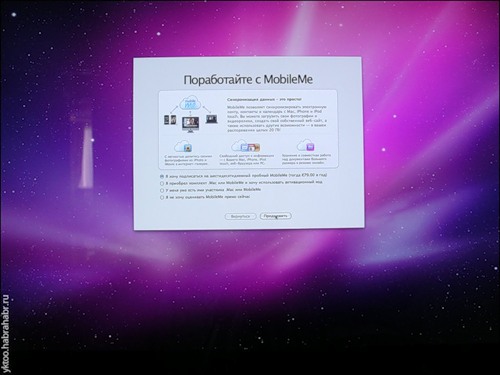
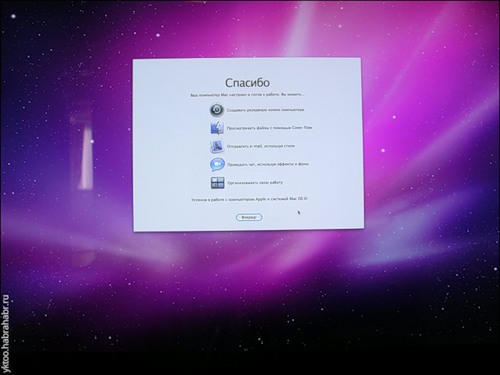
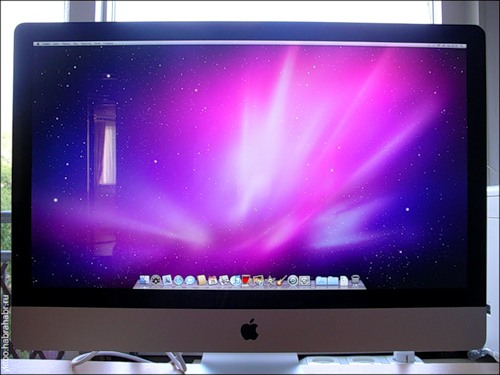
As a person who has worked all my life on Windows and Linux, it was very hard at times: absolutely everything is unusual. The menu is on top (this is constantly forgotten). The “Expand” button in the window title does not at all what you expect. Settings and tools are different. Keyboard shortcuts are unfamiliar. Safari behaves strangely, and tabbed browsing is so wild. He has a minimum of settings. I’m generally silent about the keyboard.
But everything looks beautiful and licked, we must pay tribute. Women like it.
Well, we need to move on.
3. Ubuntu + iMac
Installation
It was a small matter: you had to install your favorite Linux. But the path unexpectedly turned out to be rather thorny.
Everything happens like this:
1. Go to Mac OS X in the "Disk Utility" and squeeze the apple section. Delov for a couple of minutes, and repartition occurs directly on the running system. Impressive.
2. We put our favorite rEFIt for a convenient choice of a bootable system. A couple of nonsense.
3. Reboot. Favorite flash drive with a live distribution Ubuntu is already stuck in the back of the monitor.
rEFIt sees nothing but Mac OS X. Hmm ... Apparently, booting from USB is considered bad at Apple.
4. We take out the disc, download Mac OS X, understand the habit for a long time, and finally burn the Ubuntu 10.04 LTS ISO image onto a CD.
5. Insert the CD into the slot, it is swallowed. We are overloaded. Hooray, now rEFIt shows next to the penguin apple.
6. Select it and happily click on “Install Ubuntu”. It wasn’t there - the screen is getting darker and no longer illuminated, although the system does something there.
7. Searching the forums. Yes, 10.04 LTS has problems with the ATI driver (although previous versions were installed without problems). A proprietary driver is needed, but the installer cannot use it.
8. Download the image of Ubuntu Alternate: with the installer that works in text mode.
9. Having sighed, we get one more blank. Repeat the process.
10. Now everything starts. We answer a lot of questions of the installer, put the system on free space on the disk.
11. Installation is complete. We reboot by removing the Live CD. rEFIt clearly sees the penguin on the hard drive.
12. Download it, and in the Grub menu (displayed after that) select Recovery Mode and add it to the kernel parameters
radeon.modeset=0 nomodeset reboot=pci13. The system boots, detects a graphics problem. Choose a one-time Low Resolution Mode.
14. Ubuntu booted. We go to the proprietary drivers and install the ATI driver.
15. Add to the kernel constant parameters
reboot=pci. We are overloaded. Voila! Everything works.Bring to mind
Initially, everything except the sound , some keys on the keyboard and gestures on the Magic Mouse works .
The camera, Wi-Fi, card reader are picked up without any problems.
I did not like the keyboard right away.
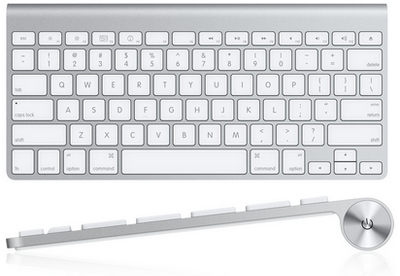
Yes, it is beautiful, aluminum and wireless, but too small - to the detriment of functionality. There are no buttons Insert, Delete, Home, End, Page Up, Page Down - all of them are replaced by combinations with the fn button. To endure such mockery, I was completely not going to.
So I headed back to MediaMarkt and bought a Mac Aluminum Keyboard (€ 39) - wired, but no less aluminum and (almost) with all the usual buttons, and two USB ports as a bonus:
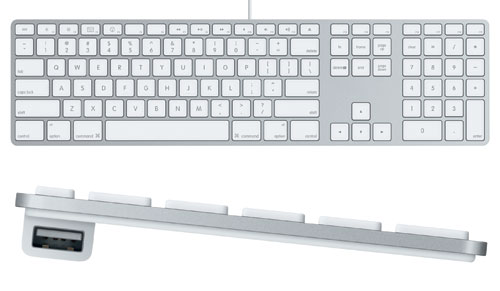
The original keyboard went into the darkness of the desk drawer.
By simple manipulationsfunction buttons are brought back to their usual state (without pressing fn they act like F-buttons, while pressing fn they act like additional keys). Now all that is missing is Insert (replaced by fn + Enter), PrintScreen, ScrollLock, Pause. The ё button is located to the left of the Z (the picture shows a slightly different keyboard), and instead of it there is a ± ± § ’button (for some reason duplicating the | | /’ and <<> ’buttons). You can live.
I’ve done even easier with the mouse: I connected my Logitech Wireless Laser Mouse: it works just fine, and does not slow down like the Apple Blue-Toothed Magic Mouse (after loading it, you had to click it for a few seconds to make it work). She has so far compiled a wireless keyboard company - until better times (support for the touch surface, they say, will already be in the next core).
Actually, I don’t need Bluetooth at all, so I didn’t even bother with it.
31. The desktop now seems vast. To consider its different parts, you have to turn your head. Here's what it looks like: But the problems did not end there. When iMac settled on the table, it soon became obvious that he was too crowded in this place. I had to go to the nearest Ikea (our favorite family store) for new furniture. The new table was soon joined by a chair, a shelf, lighting, and a bunch of little things. Now my workplace looks like this: 32.33 .
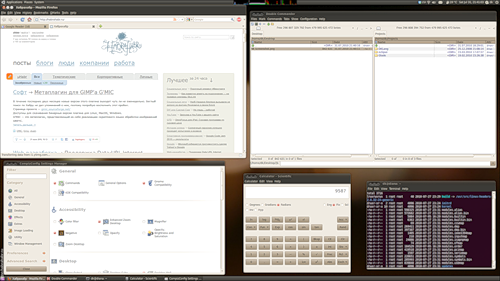
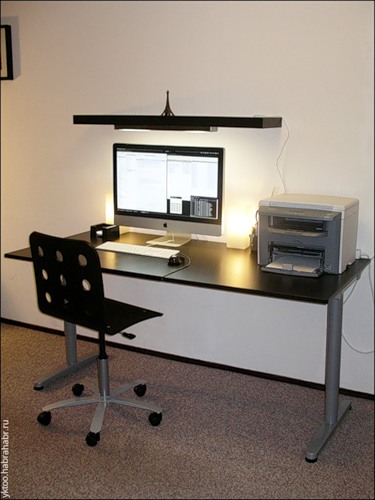

4. Organizational conclusions
In general, I am satisfied. I got the system I wanted on a computer that I like.
After some getting used to it, everything became very convenient:
- Компьютер работает тихо и занимает минимум места при своих немалых габаритах.
- Система работает надёжно. Проприетарный видеодрайвер от ATI немного сыроват, но в основном справляется хорошо.
- Клавиатура уже почти нравится.
- Камера и микрофон работают восхитительно.
- Звук более чем достаточен.
In general, I recommend.
All photos on
Yandex.Photos Upd. Thank you all for the comments. The overwhelming majority of them boils down to "well, you are a pervert, but what for?" It's very simple: I like Ubuntu and don't like Mac OS. There are many reasons: I’m used to it, familiar free software (repository too, huh), a bunch of available scripts, reluctance to spend time getting used to another system. But I like the iMac.
And that’s all, no propaganda — not iMac, Ikea, MediaMarkt or Holland. Just described his experience - maybe someone will be interested.
Upd2. Thanks for the tip about the PAE core . I knew about him, but I did not think that everything is so simple. Now all the memory is visible, in the store they did not deceive:
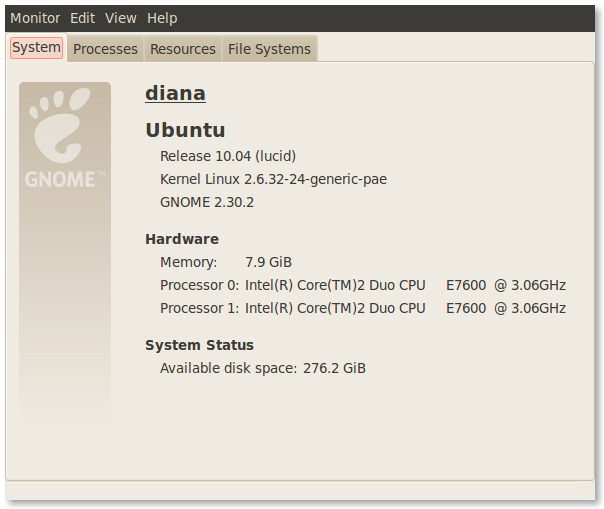
Upd3. The famous ZeroLinuxfrom ubuntuforums.org, the author of many tips for installing Ubuntu on iMac, asked me to invite. Of course, I could not refuse him. Meet: ZeroBit !
Upd4. One of the few problems with graphics - slowing down the screen when changing the window size, maximizing it and switching to full-screen mode (bug # 351186 ) - is treated by installing the patched xserver from the repository: After that, you need to install both available xserver- * updates and log in. Brakes disappear!
sudo apt-add-repository ppa:info-g-com/xserver-xorg-1.7.6-gc
sudo aptitude update
